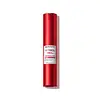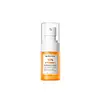What's inside
What's inside
 Key Ingredients
Key Ingredients

 Benefits
Benefits

 Concerns
Concerns

 Ingredients Side-by-side
Ingredients Side-by-side

Cyclopentasiloxane
EmollientDimethicone
EmollientDimethicone/Vinyl Dimethicone Crosspolymer
Skin ConditioningCaprylic/Capric Triglyceride
MaskingMauritia Flexuosa Fruit Oil
Skin ConditioningSimmondsia Chinensis Seed Oil
EmollientDimethiconol
EmollientHydroxypinacolone Retinoate
Skin ConditioningPhytol
EmollientOlea Europaea Fruit Oil
MaskingRetinyl Linoleate
Skin ConditioningUbiquinone
AntioxidantBisabolol
MaskingSqualane
EmollientDimethyl Isosorbide
SolventC12-15 Alkyl Benzoate
AntimicrobialDicaprylyl Ether
EmollientRetinol
Skin ConditioningPhytosteryl/Octyldodecyl Lauroyl Glutamate
Skin ConditioningTocopherol
AntioxidantRetinal
Skin ConditioningBHT
AntioxidantSolanum Lycopersicum Fruit Extract
AntioxidantAcmella Oleracea Extract
Skin ProtectingPolyglyceryl-4 Oleate
EmulsifyingOlea Europaea Leaf Extract
PerfumingMyrtus Communis Leaf Extract
PerfumingDimethylmethoxy Chromanol
AntioxidantSorbitan Laurate
EmulsifyingC18-36 Acid Glycol Ester
EmollientC18-36 Acid Triglyceride
EmollientLactic Acid
BufferingPalmitoyl Tripeptide-1
Skin ConditioningPalmitoyl Tetrapeptide-7
Skin ConditioningCanola Oil
EmollientDaucus Carota Sativa Root Extract
Skin ConditioningHelianthus Annuus Seed Oil
EmollientAroma
Beta-Carotene
Skin ConditioningTocopheryl Acetate
AntioxidantTridecane
PerfumingDaucus Carota Sativa Seed Oil
EmollientUndecane
EmollientCyclopentasiloxane, Dimethicone, Dimethicone/Vinyl Dimethicone Crosspolymer, Caprylic/Capric Triglyceride, Mauritia Flexuosa Fruit Oil, Simmondsia Chinensis Seed Oil, Dimethiconol, Hydroxypinacolone Retinoate, Phytol, Olea Europaea Fruit Oil, Retinyl Linoleate, Ubiquinone, Bisabolol, Squalane, Dimethyl Isosorbide, C12-15 Alkyl Benzoate, Dicaprylyl Ether, Retinol, Phytosteryl/Octyldodecyl Lauroyl Glutamate, Tocopherol, Retinal, BHT, Solanum Lycopersicum Fruit Extract, Acmella Oleracea Extract, Polyglyceryl-4 Oleate, Olea Europaea Leaf Extract, Myrtus Communis Leaf Extract, Dimethylmethoxy Chromanol, Sorbitan Laurate, C18-36 Acid Glycol Ester, C18-36 Acid Triglyceride, Lactic Acid, Palmitoyl Tripeptide-1, Palmitoyl Tetrapeptide-7, Canola Oil, Daucus Carota Sativa Root Extract, Helianthus Annuus Seed Oil, Aroma, Beta-Carotene, Tocopheryl Acetate, Tridecane, Daucus Carota Sativa Seed Oil, Undecane
Water
Skin ConditioningAscorbic Acid
AntioxidantButylene Glycol
HumectantGlycerin
HumectantTranexamic Acid
AstringentBetaine
HumectantPEG/PPG-17/6 Copolymer
Solvent1,2-Hexanediol
Skin ConditioningHydroxyacetophenone
AntioxidantBis-PEG-18 Methyl Ether Dimethyl Silane
EmollientAcrylates/C10-30 Alkyl Acrylate Crosspolymer
Emulsion StabilisingTocopherol
AntioxidantCitrus Reticulata Fruit Extract
Skin ProtectingHydrolyzed Sodium Hyaluronate
Skin Conditioning3-O-Ethyl Ascorbic Acid
Skin ConditioningAminomethyl Propanol
BufferingAlgin
MaskingPentylene Glycol
Skin ConditioningSodium Hyaluronate
HumectantErgothioneine
AntioxidantFerulic Acid
AntimicrobialSodium Acetylated Hyaluronate
HumectantSodium Hyaluronate Crosspolymer
HumectantCitrus Reticulata Peel Extract
Skin ConditioningNonapeptide-1
Skin ConditioningHexapeptide-2
BleachingHexapeptide-9
Skin ConditioningOligopeptide-1
Skin ConditioningLaminaria Digitata Extract
Skin ProtectingCeramide AP
Skin ConditioningCeramide As
Skin ConditioningCeramide Ns
Skin ConditioningCeramide EOP
Skin ConditioningCeramide NP
Skin ConditioningCetyl-Pg Hydroxyethyl Palmitamide
Skin ConditioningHydrogenated Lecithin
EmulsifyingCholesterol
EmollientAllantoin
Skin ConditioningPPG-26-Buteth-26
Skin ConditioningPEG-40 Hydrogenated Castor Oil
EmulsifyingPvm/Ma Copolymer
Emulsion StabilisingGlyceryl Acrylate/Acrylic Acid Copolymer
HumectantPolysorbate 20
EmulsifyingEthylhexylglycerin
Skin ConditioningWater, Ascorbic Acid, Butylene Glycol, Glycerin, Tranexamic Acid, Betaine, PEG/PPG-17/6 Copolymer, 1,2-Hexanediol, Hydroxyacetophenone, Bis-PEG-18 Methyl Ether Dimethyl Silane, Acrylates/C10-30 Alkyl Acrylate Crosspolymer, Tocopherol, Citrus Reticulata Fruit Extract, Hydrolyzed Sodium Hyaluronate, 3-O-Ethyl Ascorbic Acid, Aminomethyl Propanol, Algin, Pentylene Glycol, Sodium Hyaluronate, Ergothioneine, Ferulic Acid, Sodium Acetylated Hyaluronate, Sodium Hyaluronate Crosspolymer, Citrus Reticulata Peel Extract, Nonapeptide-1, Hexapeptide-2, Hexapeptide-9, Oligopeptide-1, Laminaria Digitata Extract, Ceramide AP, Ceramide As, Ceramide Ns, Ceramide EOP, Ceramide NP, Cetyl-Pg Hydroxyethyl Palmitamide, Hydrogenated Lecithin, Cholesterol, Allantoin, PPG-26-Buteth-26, PEG-40 Hydrogenated Castor Oil, Pvm/Ma Copolymer, Glyceryl Acrylate/Acrylic Acid Copolymer, Polysorbate 20, Ethylhexylglycerin
 Reviews
Reviews

Ingredients Explained
These ingredients are found in both products.
Ingredients higher up in an ingredient list are typically present in a larger amount.
Tocopherol (also known as Vitamin E) is a common antioxidant used to help protect the skin from free-radicals and strengthen the skin barrier. It's also fat soluble - this means our skin is great at absorbing it.
Vitamin E also helps keep your natural skin lipids healthy. Your lipid skin barrier naturally consists of lipids, ceramides, and fatty acids. Vitamin E offers extra protection for your skin’s lipid barrier, keeping your skin healthy and nourished.
Another benefit is a bit of UV protection. Vitamin E helps reduce the damage caused by UVB rays. (It should not replace your sunscreen). Combining it with Vitamin C can decrease sunburned cells and hyperpigmentation after UV exposure.
You might have noticed Vitamin E + C often paired together. This is because it is great at stabilizing Vitamin C. Using the two together helps increase the effectiveness of both ingredients.
There are often claims that Vitamin E can reduce/prevent scarring, but these claims haven't been confirmed by scientific research.
Learn more about Tocopherol